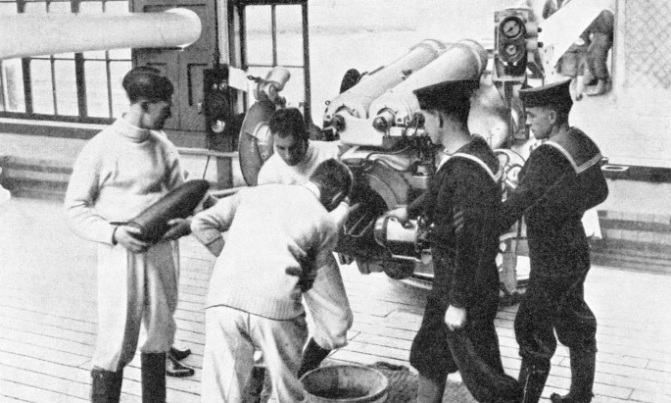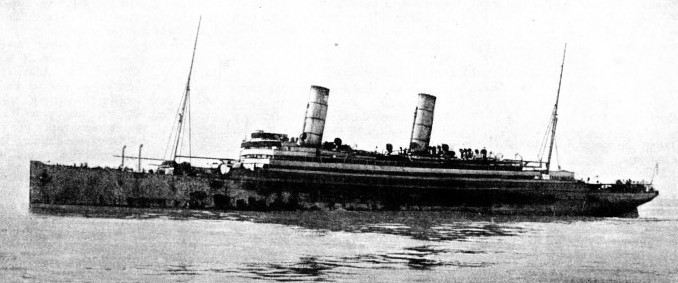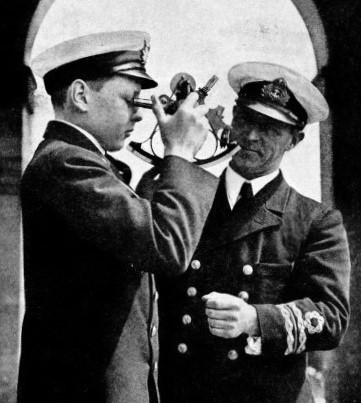

© Shipping Wonders of the World 2012-

The Royal Naval Reserve
To meet any sudden emergency, the Navy must always have at its disposal a large number of high trained officers and men. The Royal Naval Reserve, founded in 1859, has a magnificent record of wartime service and a growing list of applicants for commissions

GUNNERY TRAINING is an important branch of the routine work of the Royal Naval Reserve. This photograph shows R.N.R. officers under instruction at the Royal Naval School of Gunnery, Devonport.
EVERY officer and man in the Royal Naval Reserve, except the accountant officers, earns his living at sea in peace time. The Navy has looked to the Merchant Service for its men from time immemorial, and since the days of Alfred the Great every English professional seaman has been liable to serve in the Navy when wanted.
During the war of 1914-
Shortly before the war a new section was founded which owed its inception to the enthusiastic advocacy of the late Lord Charles Beresford. That was the Trawler Section, which was carefully
organized to maintain the tradition of the fishing industry and to let the men serve in the conditions to which they were accustomed. It was believed that their trawling experience would prove useful in minesweeping.
When war broke out in 1914 there were enrolled in the Royal Naval Reserve nearly 20,000 officers and men, already trained to more than the elements of naval service and ready for mobilization as soon as their ships reached port. The older vessels of the reserve were permitted to put to sea, and there was immediately an unprecedented rush of every type of merchant officer and man to join the Reserve.
During the war every section of the R.N.R. acquitted itself with the greatest credit. The service provided the greater part of the crews of the old ships which had been kept in reserve, and it suffered a terrible mortality. Officers and men served in the regular ships of the Grand Fleet and in all the other naval formations, taking their full part with their brothers in the regular service.
When new sloops and patrol vessels were commissioned in dozens, it was to the R.N.R. that the Admiralty looked for their crews and, as their work was largely concerned with mercantile matters, their peace-
Before the end of the war the force supplied navigating officers to nearly all submarines, and in Q-
The casualty list was heavy, but the Royal Naval Reserve earned for itself a reputation which will never be forgotten, either by the country or by the Navy. After the war one of the greatest tasks of the Admiralty was to consider the strength and weakness of the R.N.R. organization as proved by experience, and to mould a post-
In 1920 the Admiralty laid before Parliament the outline of a scheme and prefaced it with a generous tribute. The trust that had been reposed in the Reserve had been abundantly justified.
The proposal was to retain a sufficient number of officers and men to meet the needs of the fleet should war break out. At the same time, the authorities were careful to preserve the machinery which had been built up for the enrolment of the whole available force later on.
With the Royal Naval Volunteer Reserve, the R.N.R. was to be organized in three classes — for fleet service, for patrol service, and for shore service. Fleet service was to include the ships of the regular Navy, auxiliary cruisers and other larger vessels, but the patrol service was to include only anti-
Perhaps the most important step was to set up an R.N.R. Advisory Committee under the Presidency of the Admiral Commanding Reserves. This Committee, which had at its disposal the united knowledge and experience of the Navy, the merchant seaman and the ship-
The R.N.R. officer of to-
Searching Tests
Below the commodore’s rank are those of captain, commander, lieutenant-
In each rank the officer works alongside his opposite number in the regular service. In all professional branches he is expected to have the same technical knowledge as the naval officer and he is given every opportunity of obtaining it, often at some sacrifice to himself.
Captains and commanders can take the highly technical war courses which are held regularly at the Royal Naval College at Greenwich. Each course lasts for some months and deals with strategy, tactics, command and similar subjects. The junior officers are entered either as midshipmen or as sub-
They have to be British-
The R.N.R. officer has to go through his courses of gunnery, torpedo work and navigation training as does the regular officer, but normally he cannot specialize in any branch in the same way. Periodically he is appointed to one of the special naval training establishments for a training or refresher course in one or other of their subjects. Before being accepted as a fully qualified officer he has to serve twelve months in the Royal Navy.
Formerly this period was generally served in one ship, but nowadays the time is divided to give the officer the widest experience possible. It includes a spell in destroyers and submarines which have their own particular routine.
In return for his services, the R.N.R. officer receives a retaining fee of £25 a year, the ordinary pay of his naval rank while he is serving, and help in the purchase of his expensive uniform and equipment.

MANNED ALMOST ENTIRELY BY R.N.R. OFFICERS AND MEN, the Cunard liner Carmania, during the early stages of the war of 1914-
Although the Admiralty shows the utmost consideration in giving R.N.R. officers appointments which will not entail much personal expenditure, there is seldom much financial balance to tempt an officer to give up so much spare time to national service.
The large number of applicants for R.N.R. commissions can be accounted for only by patriotism and a fine sense of public duty, as well as an appreciation of the honour of the service. The senior R.N.R. captain who is selected each year to serve as Reserve A.D.C. to the King is the most envied man in the Merchant Service.
In much the same way as officers, the lower deck ratings are enrolled with due regard for their normal mercantile employment and with the idea of making the greatest naval use of their commercial experience. It is not possible, however, to provide the ratings with the same opportunities of promotion as the officers, because of the work which the routine of the Navy demands of the higher ratings.
All R.N.R. ratings are enlisted for a period of five years. At the end of their term they may be permitted, if they have proved themselves of value to the Navy, to re-
The recruit can choose whether he will enter the general or the patrol service, but in*practice all the deep-
Before a man enters into the R.N.R. his qualifications are carefully scrutinized and a high standard is demanded. There must be no doubt about his skill as a seaman, an engine-
Applicants wishing to become seamen or stokers have to be between eighteen and twenty-
As with the commissioned officer, the R.N.R. rating is first accepted on probation only, and is subject to careful scrutiny while “provisionally enrolled”. When he has completed his first year’s drill and training to the satisfaction of his seniors he is confirmed in his rating.
The first year’s training as a seaman begins with twenty-
With stokers the routine is essentially the same. They do less time in barracks, however, and more time afloat, as naval boilers and methods of stoking generally differ radically from those in use in the Merchant Service.
In return for these-
In addition, they receive naval pay while they are under training, or mobilized for war. They have the same uniform as naval ratings except that they carry the words “Royal Naval Reserve” on their cap tallies instead of the name of the ship.
When it is under training or mobilization the R.N.R. serves under the White Ensign. In peace time a
merchant ship commanded by an R.N.R. officer, with more than a certain number of R.N.R. officers and ratings in the crew, is permitted by the Admiralty to fly the Blue Ensign instead of the Red. It is a jealously guarded privilege and every care is taken that it shall not be abused.
The recent decision to increase the strength of the Royal Navy has made the Royal Naval Reserve more important than ever. The main reasons are, first, because it will probably be necessary to transfer some of the fully-

NAVIGATIONAL INSTRUCTION is given to cadets by R.N.R. officers at the Nautical College at Pangbourne, Berks. The rank of cadet in the Royal Naval Reserve is confined almost entirely to mercantile cadets in training ships such as the Worcester and the Conway, and at the Pangbourne Nautical College.
You can read more on
“The Royal Naval Volunteer Reserve”
on this website.